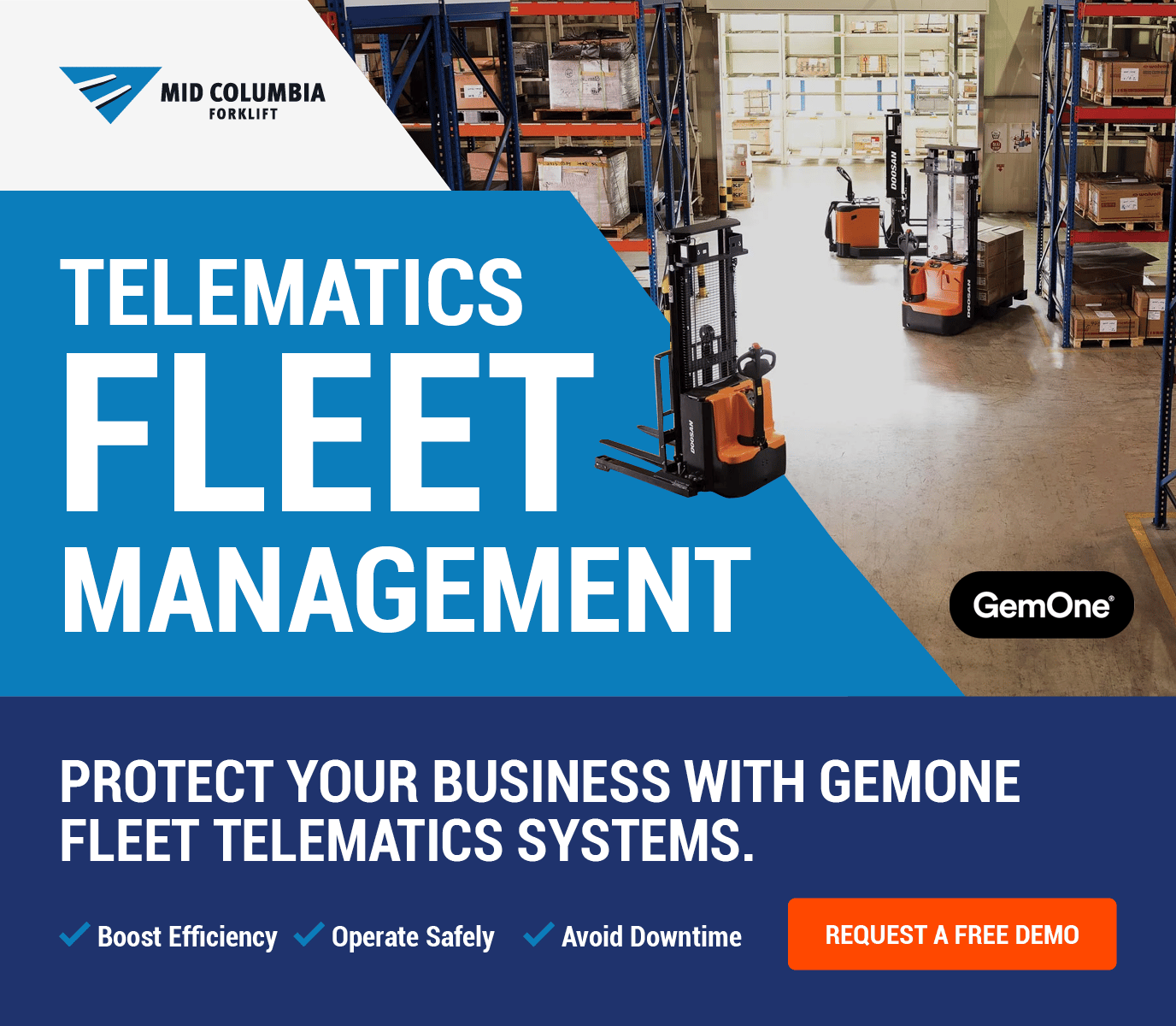5 Benefits of Telematics for Fleet Management
by Dan Livingston, on December 13, 2024 at 6:59 AM
 Imagine you need to navigate a dense, difficult forest. You have a choice between two maps. The first is a high-resolution satellite map with marked roads and trails, so you just have to pick a path to follow. The second map is a crayon drawing with a dotted red line leading to an X on the other side of the forest. Which would you choose?
Imagine you need to navigate a dense, difficult forest. You have a choice between two maps. The first is a high-resolution satellite map with marked roads and trails, so you just have to pick a path to follow. The second map is a crayon drawing with a dotted red line leading to an X on the other side of the forest. Which would you choose?
The crayon map is what you're working with when you try to manage your forklift fleet without data-backed solutions. The high-res satellite map is a telematics system. Telematics offers the data you need to take all the guesswork out of managing your forklift fleet. These systems make it easy to know what your forklifts and team need to reach peak performance. Read on to learn what telematics are and how they can revolutionize your facility.
What Is Telematics?
Forklift telematics systems are data collection and management systems that provide a bird’s eye view of your fleet and detailed insights into each fork truck’s operations. These systems collect a dizzying array of metrics, including but not limited to:
- Speed
- Location
- Route mapping
- Operator identity
- Collision detection
- Fuel consumption
- Battery level
- Braking pressure
- Key hours
- Error codes
- Operator productivity metrics
- Other safety-related metrics
Some telematics systems take data collection a step further by allowing you to influence forklift use from a distance. For example, Toyota’s MyInsights+ Productivity includes geofencing, zone alerts, a pre-operational safety checklist, diagnostic troubleshooting, operator certification tracking, impact lockout, and messaging. Telematics systems provide complete access to the data you need to manage your fleet.
How Do Telematics Improve Your Fleet
Telematics fleet management systems collect, report, and manage data about nearly every facet of each equipped forklift. Analysis of this data and the ability to access each forklift from a distance have innumerable benefits, but there are six that really stand out.
1. Take the Guesswork Out of Fleet Management
Think of telematics as a high-resolution map of your forklift fleet. You can zoom out to view your whole fleet, zoom in for a granular analysis of an individual forklift, or find a suitable middle view. Best of all, you can do any of these at any time. In this way, telematics-based forklift management systems offer the most comprehensive understanding of your fleet. With so many high-precision metrics, you can easily spot inefficiencies in your operation and identify the steps needed to correct them. Instead of relying on trial and error, you get data-backed solutions that are sure to improve productivity.
2. Identify Your Best (and Worst) Forklift Operators
Forklift operation is a skill. Some people are better at it than others. However, identifying your top operators can be more challenging than expected. Most people are in the habit of doing the right thing when being watched, but your best forklift operators will keep doing it right even when working independently.
Telematics like Clark Smart Fleet allows you to monitor your forklifts even when the operators work alone. Sensors record forklift speed, fuel consumption, g-force, and other safety metrics. By analyzing these, you can tell which drivers operate safely all the time and which are cutting corners when they think no one is looking.
3. Improve Forklift Safety
Monitoring how your forklifts are used doesn't only help you identify your best drivers. It also shows you which bad habits are most common throughout your team. Identifying these safety issues tells you where to focus follow-up safety training and helps ensure the techniques taught are appropriately applied.
Additionally, geofencing allows you to mark certain areas of your facility as out-of-bounds to your forklift fleet. This is especially useful for creating pedestrian safety corridors or marking off areas that pose a danger to the forklift and driver. Similarly, telematics offer speed controls, allowing you to set maximum operating speeds.
Imagine the peace of mind from knowing your warehouse is safe and runs smoothly. You can:
- take pride in creating a safer work environment,
- build trust with your team,
- and reinforce your reputation as a responsible leader.
Plus, the confidence you gain in your operations allows you to focus on growing your business, knowing safety is never compromised.
4. Optimize Maintenance Schedules
Telematics-based forklift fleet management systems like the GemOne Sapphire monitoring system also offer deep insight into the health of your individual forklifts. Keeping a close watch on these sensors will warn you when a forklift ceases operating within its ideal performance zone, indicating impending functionality issues. This data indicates the need for maintenance and allows you to schedule service when it best fits into your operational schedule. Even better, staying on top of preventative maintenance prolongs the life of your forklifts and improves their resale values.
5. Streamline Regulatory Compliance
OSHA compliance requires safety inspections and training for all forklift operators. Keeping up with these regulations can be a challenge for many logistical reasons. Operators get busy doing their jobs and forget about safety inspections and refresher training. Suddenly, entirely by accident, you have an OSHA violation on your hands.
Forklift telematics systems like Toyota’s MyInsights+ Compliance include a pre-operational checklist that operators must complete before moving the forklift, helping to satisfy OSHA requirements. Additionally, MyInsights+ Productivity keeps your forklifts out of the hands of people who shouldn't be using them. Operator access controls verify users before allowing them to drive the forklift. Likewise, they lock out operators with expired or invalid credentials, ensuring only authorized users get behind the wheel.
Explore Your Telemantics Options
There are very few downsides to incorporating telematics into your fleet management. In fact, many forklifts already have these sensors built-in. However, the type and volume of forklift fleet data you want depends on your operational needs. Let us help you choose the best forklift fleet management system for your fleet. Our experts have the knowledge and experience to help you identify what metrics and features are helpful and which are just noise. To learn more about telematics or to find out if they’re right for your operation, contact us online or visit your local Mid Columbia Forklift.
Auburn 253-854-5438
Pasco 509-547-7413
Wenatchee 509-663-9009
Yakima 509-457-5137
Further Reading
4 Top Reasons to Update Your Forklift Certification
How to Stay on Top of Forklift Fleet Maintenance
The 3 Steps to Improve Forklift Pedestrian Safety in Your Warehouse




